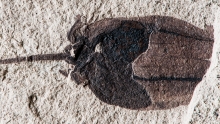The nightshade family has some of the most economically important and useful crops on Earth. That includes, of course, deadly nightshade or belladonna, which produces the medicine atropine, as well as potatoes, tomatoes, chili and bell peppers, tobacco and eggplant.
Scientists thought the family came into existence about 40 million years ago based on genetic evidence from living plants and the fossil record, says Richard Olmstead, an evolutionary biologist at the University of Washington. But the discovery of two new nightshade fossils pushes the age of the family back considerably further.
The fossils are imprints of ancient tomatillos about the size of a pen cap. The tomatillo's papery husk is left behind as a network of fragile black lines on a slab of white rock. Based on atomic age dating, the fossils are about 52 million years old, at least a dozen million years older than when scientists thought the first nightshade plant emerged on Earth, says Peter Wilf, a paleobotanist at Penn State University and the lead author of a new paper published in Science.
Wilf and his team found the fossils in the Patagonia region of Argentina, at a site that was once an ancient lake bed. "The plants that generated these fossils were alive in a temperate rain forest next to a volcano," he says. "When it finally snapped together [that] we were looking at a fossil tomatillo, it was quite shocking. It was disbelief. It was joy coupled with disbelief."
The discovery changes the history of nightshades, says Olmstead, who was not involved with the work. There is no other nightshade fossil as well-preserved as these, which show details of the tomatillo's stem, husk and berry. "It's a tremendous find. It provides insight totally absent from the fossil record and our understanding of the family prior to this," says Olmstead.
Photo:
This 52-million-year-old fossilized tomatillo was found in Patagonia, Argentina, shedding light on the origin of nightshade plants. In this specimen, the slender stalk is preserved, and the former papery and lobed husk is broken at top to reveal the large, fleshy berry underneath — now turned to coal. PETER WILF, PENN STATE UNIVERSITY
Read the full article on KUOW.

